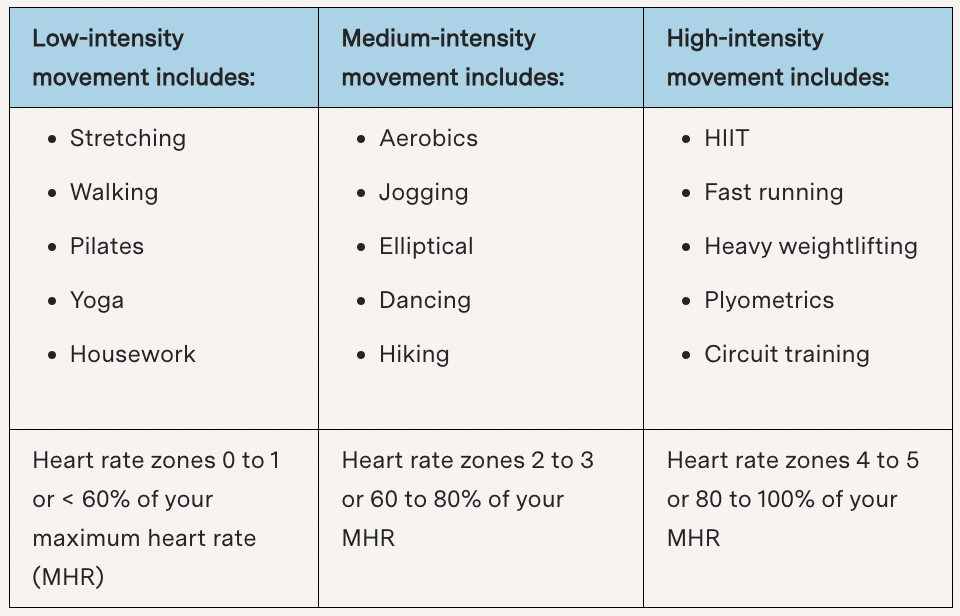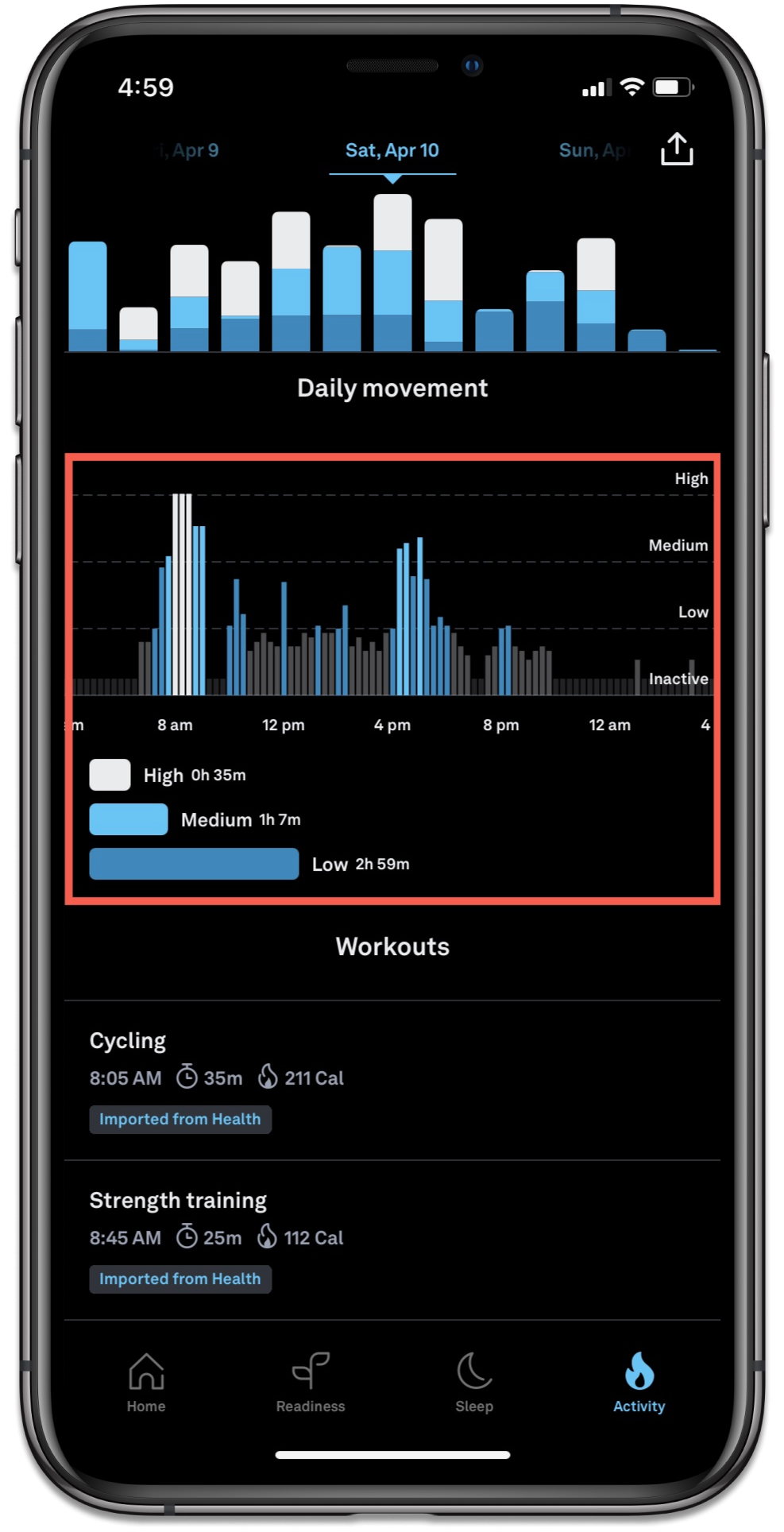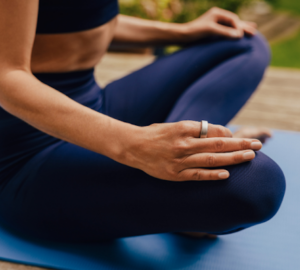It’s a common misconception that you have to do high-intensity workouts to yield results. The harder, the better, right? In reality, a well-rounded exercise routine includes low, medium, and high-intensity workouts.
Here are some examples of each type of workout intensity:

Track Your Exercise Intensity with Oura
A good balance of different types of movement helps keep your body active but not overworked.
With Oura, you’re able to see how much low, medium, and high-intensity movement you get in a day in your Daily Movement Graph.

LEARN MORE: How Oura Measures Steps & Activity
On the Activity tab on the Oura App, you’ll notice a graph that shows your activity levels throughout the day. It’s categorized into colors:
- White: High-intensity
- Light blue: Medium-intensity
- Blue: Low-intensity
This can help you balance your overall activity level and keep track of how it all adds up to your overall Activity Score. You’ll probably see on the Oura App that most of your daily movement comes from low-intensity activities like walking to the coffee shop, doing housework, or taking the stairs in the subway. That’s fantastic—it shows you’re staying active throughout the day, which is essential for your overall health.
However, intentionally incorporating some higher intensity exercise will help you to bring your fitness to the next level. Keep reading to learn some key benefits.
Benefits of Low- and Medium-Intensity Exercise
1. It activates the parasympathetic nervous system, giving your body time to “rest and digest.”
Low-intensity exercise activates the parasympathetic nervous system, or “rest-and-digest” mode. When this system is activated, your heart rate and blood pressure lowers, and important autonomic functions, like digestion, occur.
In other words: Your body is in a state of relaxation, and “the more time you spend in this state, the healthier you are,” says Lauren Roxburgh, a certified trainer, movement and fascia expert, and founder of the Aligned Life Studio.
READ MORE: How Stress Works: The Mind-Body Connection
2. It benefits your heart health.
Walking and other types of low-intensity exercise have been shown to improve markers of heart health. A meta-analysis published in the European Journal of Epidemiology found that walking for 30 minutes a day, five days per week, decreases the risk of coronary heart disease by 19 percent.
| Member Tip: Monitor your heart health using two new features: Cardio Capacity and Cardiovascular Age. |
3. It’s accessible for most people.
Low-intensity exercise is suitable for many people, regardless of age, injury recovery, pregnancy status, or fitness level.*
In fact, one study found that low-intensity exercise is an entryway into fitness and may prevent cardiovascular events in people with low fitness levels. Even if you’re not a big exerciser, doing low-intensity exercise like walking can have substantial health benefits.
*Always check with your healthcare provider before starting a new exercise routine.
4. It can promote high-quality sleep.
Low-intensity exercise is linked to better sleep quality. Studies have found that exercise reduces sleep latency—the time it takes to fall asleep. In one study in the journal Sleep Health, researchers found that low-impact, low-intensity physical activity improved multiple markers of sleep quality.
| Member Tip: On the Oura App, see if your workouts improve your sleep quality by using Tags and Discoveries. |
5. It can improve your recovery.
Exercising in heart rate zones 0 to 2, known as “recovery zones,” can boost your recovery by increasing blood flow to remove lactic acid and metabolic waste from your muscles. It also helps reduce post-workout muscle soreness by keeping your muscles flexible during the post-workout recovery period, speeding up the overall recovery process.
RELATED: How Sleep Helps Muscle Recovery and Growth
Benefits of High-Intensity Exercise

1. It can improve your cardiorespiratory fitness.
To boost your fitness levels, high-intensity exercise is key. It pushes your cardiovascular system to deliver more oxygen to your muscles, leading to adaptations like increased capillary density, improved cardiac output, enhanced oxygen extraction, and better mitochondrial function. These changes significantly enhance cardiovascular fitness.
A 2014 study in the British Journal of Sports Medicine found that high-intensity training was twice as effective as moderate-intensity exercise for improving cardiorespiratory fitness.
| Member Tip: VO2 max is a key marker of cardiorespiratory fitness, and you can track it on Oura. See if incorporating more high-intensity workouts helps you improve this metric. |
2. It’s time-efficient.
You might notice only a small amount of white on your Oura Daily Movement Graph, even if your workout felt intense. This can seem minimal compared to your low- and medium-intensity activity, but that’s normal. The more intense the workout, the shorter it needs to be.
For example, Tabata, a type of high-intensity exercise, involves 20 seconds of all-out effort followed by 10 seconds of rest, repeated for eight rounds, totaling just four minutes. Despite its brevity, a clinical trial showed that Tabata improved speed, VO2 max, and anaerobic capacity by 28%, outperforming moderate-intensity workouts.
3. It can promote fat burning.
High-intensity exercise promotes fat burning through a metabolic effect called excess post-exercise oxygen consumption (EPOC), or the “afterburn.” During anaerobic exercise, you create an oxygen debt, leading to increased oxygen consumption and metabolic activity after your workout. This process replenishes oxygen, clears byproducts, and repairs muscles.
A 2011 study found that participants burned 112 calories during a six-minute HIIT workout but continued to burn calories for 24 hours due to EPOC, resulting in a total of 457 calories burned from the session.
4. It’s beneficial for your hormones.
High-intensity exercise triggers favorable hormonal responses that aren’t as pronounced in low or moderate-intensity workouts. During HIIT, your body releases hormones like testosterone, insulin, growth hormone, and catecholamines (adrenaline and noradrenaline), which support muscle growth, fat metabolism, insulin sensitivity, and exercise performance.
A 2017 study showed that HIIT counteracted elevated glucose, insulin, and free fatty acids in male participants, helping maintain insulin sensitivity even in an insulin-resistant state.
5. It can increase strength, power, and muscle mass.
High-intensity exercise activates more motor units and muscle fibers, promoting better muscle recruitment, hypertrophy, and neural adaptations. These changes enhance muscle strength, force, and power. One study concluded that high-intensity training is “an efficient training protocol, which takes less time and produces a better improvement in anaerobic power.”
READ MORE: How Sleep Helps Muscle Recovery and Growth
How Much Low, Medium, and High-Intensity Activity Should You Get Each Week?
According to the World Health Organization (WHO), adults should aim to get:
- At least 150–300 minutes of medium-intensity aerobic physical activity or 75–150 minutes of high-intensity aerobic physical activity per week.
- Muscle-strengthening activities at medium or high intensity on two or more days a week.
The duration changes depending on the intensity of the exercise performed. Combining some low-intensity, some medium, and some high-intensity activity is optimal, according to experts.
Here’s an example weekly workout routine that combines each type of activity for the recommended duration:
- Monday: 60-minute zone 2 walking.
- Tuesday: 45-minute zone 4 full-body weight-lifting.
- Wednesday: 30-minute zone 2 cycling.
- Thursday 15-minute zone 5 HIIT workout.
- Friday: 60-minute zone 2 yoga class.
How much low or high-intensity exercise you do depends on your current fitness level, physical capabilities, goals, age, and other factors. Ideally, follow a workout routine that keeps you healthy and active—and one that you can maintain over time.




